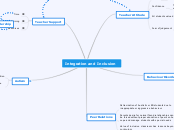Integration and Inclusion
Teacher Attitude
Stress
Overwhelmed
Confidence
Teachers that feel confident in dealing with students with higher needs have students that achieve better
All students valued equally
Students with special needs demand more time and energy thereby shortchanging students without disabilities
Fear of judgement
Teachers that are uncomfortable with students with high needs are afraid of expressing this for fear of judgement from other staff
Behaviour Disorders
Disruptive
Depressive
low motiviation
Hyperactive
Aggressive
Physical
Verbal
Oppositional
Teacher Support
Time
Training
Resources
Autism
Distruptive behaviours during times of transition
classrooms and schedules not designed to meet the needs of many autistic students
Peer Relations
Ostracization of Austistic or BD students due to inappropriate or aggressive behaviour
Parents desire for normal friend relationships can not be forced without proper education of peers on how to cope and manage students with special needs
Value of inclusive classroom has lessons beyond the curriculum
